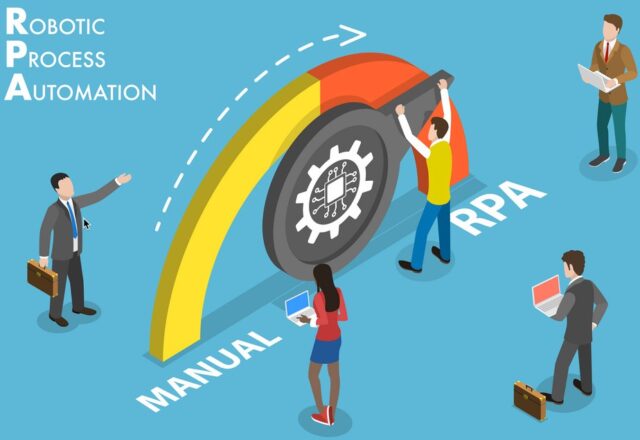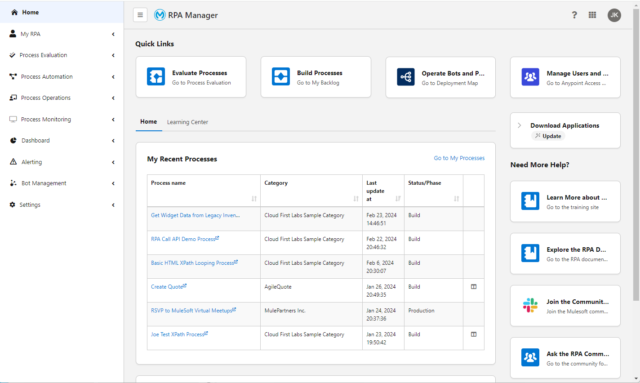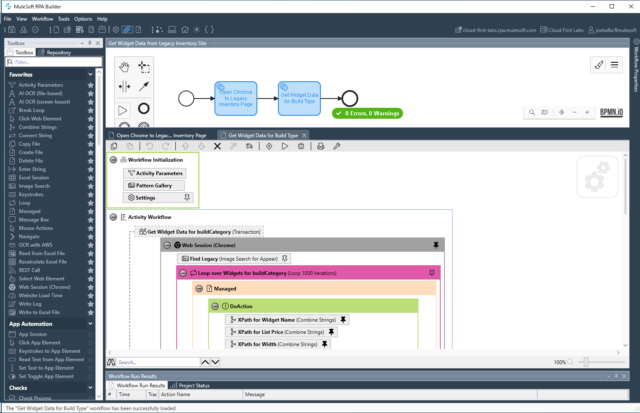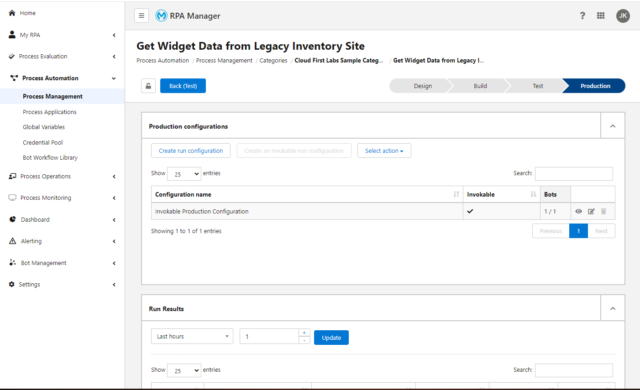About Robotic Process Automation
Many organizations are searching for ways to reduce operational costs while increasing the accuracy, quality, and consistency of manually executed tasks. Robotic Process Automation (RPA) is a way to achieve these goals. RPA technology allows configurations of “bots” that mimic human-computer interactions to perform tasks at high volume and speed. Tedious, repetitive tasks and business-rule-driven processes are good candidates to be executed by RPA bots. These bots can extract data from applications and copy data between systems, even legacy applications and other systems that lack APIs.

MuleSoft RPA is a powerhouse RPA technology platform that enables organizations to take advantage of the benefits of automation. MuleSoft is a longtime leader in integration technology and has built MuleSoft RPA to extend solutions even to systems with insufficient traditional integration solutions (such as Web Services or APIs). On top of its integration expertise, MuleSoft comes with the added benefit of being a Salesforce company. The Salesforce backing means MuleSoft RPA customers can count on quality support from the Salesforce organization and experienced Salesforce-partnered strategic implementors.
With its toolset of RPA Recorder, RPA Builder, RPA Manager, and RPA Bots, MuleSoft RPA makes automation development straightforward to build, to maintain, and to execute. Whether a given RPA process needs to run once, run regularly on a schedule, or run dynamically via HTTP request, MuleSoft RPA can set up the processes as required. MuleSoft RPA enables organizations to connect difficult-to-integrate systems, to reduce monotonous work, and to improve quality of business operations.
Automating Repetitive Tasks
RPAs are effective across a variety of industries. They are especially useful for automating “swivel chair tasks”. Swivel chair tasks are processes that are carried out by employees manually entering the same data into multiple systems, often toggling between tabs, applications, or terminals to do so. This type of work tends to feel a little “brainless”. This is often uninspiring to the employee(s) and it can lead to employee dissatisfaction. Many of these boring repetitive processes are error-prone due to the manual and repetitive nature of work.
RPAs can even the speed of execution for these processes. RPA bots can often be configured to carry out their specific work much more quickly than a human visually and manually working through a process. And since the RPAs can be triggered automatically, the processes do not need to wait for the availability of the employee. Pushing the work to the RPA bot allows the workflow to quickly reach its next relevant step while the employee is freed up to perform more engaging and higher-value work.
Many legacy systems utilized by organizations require significant amounts of swivel chair work. Legacy systems often lack API capabilities or have APIs insufficient for the business needs of a given organization. Often, the organization is dependent on such legacy systems anyway and employees do tedious data scraping and copy/paste tasks to and from these systems. This work is vital to an organization’s business needs but is burdensome based on the manual efforts required. RPAs can be used integrate these key legacy systems with more modern systems in an automated and robust fashion, paving the way for innovation and more efficient processing. Serving as a bridge from legacy to more modern applications, RPAs can play an important role in an organization’s digital transformation strategy.
Cloud First Labs’ Recommended Solution: MuleSoft RPA
At Cloud First Labs, we recommend using MuleSoft RPA to take care of organizational automation needs. It is backed by technology industry leaders, it supports the entire automation lifecycle, and its set of tools plugs in seamlessly to integrated, modernized environments. MuleSoft RPA provides outstanding solutions for eliminating waste and gaining technological efficiencies throughout an organization’s business processes.
MuleSoft RPA: Backed by Industry Leaders
MuleSoft RPA is built by MuleSoft, which has been a leader in the integration software industry since its founding in 2006. MuleSoft has developed a top-tier integration platform as a service (iPaaS): Anypoint Platform. The Gartner Magic Quadrant for Integration Platform recognizes MuleSoft as a leader in the integration world, and MuleSoft’s RPA Manager and associated tools fit right into the award-winning Anypoint Platform. With MuleSoft long recognized as a leader in integration technology, MuleSoft RPA provides yet another tool for ensuring businesses can connect with and integrate all sorts of disparate systems to accomplish business processes as effectively as possible.
The MuleSoft support process is a crucial part of MuleSoft’s success, and that support is available to MuleSoft RPA users the same way it is available to users of MuleSoft’s other myriad of products and services. The same way MuleSoft’s products help systems connect with other systems across the world, their support team likewise connects worldwide customers with the support they need. With a large and helpful team of support staff scattered across several continents, MuleSoft has the organizational infrastructure in place to provide effective support promptly regardless of what the issue is, when it happened, or where the event took place.
Part of the reason for MuleSoft’s trustworthiness and success is the fact that it is a Salesforce company. Salesforce acquired MuleSoft in 2018 and it has helped grow and deepen MuleSoft’s documentation, support, and capabilities. Salesforce was selected as the Best Software Company in 2024 by G2. With MuleSoft’s deep roots in integration and Salesforce’s backing and support, customers can be confident that their experience with MuleSoft RPA will be best-in-class.
MuleSoft RPA: Supports Whole Automation Lifecycle
There are several phases to the process automation lifecycle, MuleSoft RPA provides a full framework of tools that enable organizations to perform every aspect of it. From Evaluation to Design to Build to Test to Production (Deploy and Monitor), MuleSoft RPA ably provides useful and fully-featured tools.

Tasks and business processes should initially be vetted to see whether they are a good fit for automation. MuleSoft’s RPA Manager can be used to help identify whether a given process is a good candidate for automation. Out-of-the-box functionality includes industry-standard settings for evaluation, but it allows for customization specific to organizational needs. Furthermore, the RPA Manager provides tooling to help determine the break-even point for when a given automation becomes profitable.
The design phase is important for budding RPA processes; this is where the overall approach and flow are identified and visually illustrated. RPA Manager is used in this phase to build out a design diagram using industry-standard Business Process Model and Notation (BPMN). The BPMN diagram built in RPA Manager can be used in RPA Recorder which is useful for “recording” a user’s actions on a computer as they work through a given business process. In RPA Recorder, the actions taken by the user can be fit into the relevant components of the BPMN diagram and documentation can be captured at each step along the way for later use in the Build phase.
MuleSoft RPA’s tool for the Build phase is the aptly named RPA Builder. In RPA Builder, the development of the actual RPA work is completed. Using the aforementioned BPMN diagram and/or the documentation and workflow steps generated by RPA Recorder, RPA Builder takes the output of the design process and turns it into the actual steps to be completed by an RPA Bot. RPA Builder is where the exact steps to be executed by eventual RPA bots are configured; this is where the instructions for the bot to “click here” or to “enter XXX text here” are set up. RPA Builder has a vast toolbox of options that allow for nearly any type of on-screen activity to be configured: from clicking to parsing Web pages to scraping text via Optical Character Recognition (OCR), and beyond. RPA Builder enables the builder to not only build bot instructions but also debug and test them. In RPA Builder, input data and output data (both represented as Activity Parameters) can be configured to ensure the RPA process receives and returns appropriate data.

After publishing an RPA process built in RPA Manager, the RPA process moves from the Build phase to the Test phase. The Test phase is vital to the lifecycle of an RPA process, and it requires two main components of MuleSoft RPA: RPA Manager and one or more RPA Bots. An RPA Bot is a Windows computer or VM configured to be able to run MuleSoft RPA processes. RPA Manager is used to configure test plans and to determine which RPA Bot(s) to execute a given test plan on.
Once the RPA process has been suitably tested, it is ready to move to the Production phase. Similar to what gets configured in the Test phase, this configuration uses a combination of RPA Manager and RPA Bots. RPA Manager sets up the schedule or invokable nature of the relevant RPA process and it provides configurations for default Activity Parameter values and for the RPA Bot(s) the process will get deployed to. Upon execution of the deployed processes, the executing RPA Bots provide ample data back to the RPA Manager for monitoring (including near-real-time screen look-ins), for checking success/failure status, and for troubleshooting.

Evaluation, build, design, testing, and production are all important phases of building RPAs. No matter what part of the RPA process is involved, MuleSoft RPA has tooling to support organization automation success.
MuleSoft RPA: Seamlessly Plugs into Integrated Environment
MuleSoft RPA does not operate in a silo; it can seamlessly tie into various technology environments and platforms. While there is special tooling that makes MuleSoft RPA even easier for existing MuleSoft or Salesforce customers, MuleSoft RPA can be readily utilized in a wide variety of environments.
Production-phase MuleSoft RPA processes can be invoked via HTTP API calls if configured in such a way, that if an outside system needs to trigger an RPA process, it just calls the generated RPA API URL generated by RPA Manager (found in Anypoint Exchange). Anypoint Platform’s API Manager can be used to secure this RPA API URL. In cases where other systems cannot invoke an RPA process, RPA Manager enables the process to be scheduled to run on a specific frequency. This is useful in cases where a given process should be run consistently (whether hourly, daily, weekly, etc.).
Not only can RPA processes be triggered by an API call, but RPA processes can call other APIs as well. As part of the Toolbox in RPA Builder, RPA processes can make outbound API calls and use the returned data.
The ability of RPA processes to be called as APIs and to call other APIs helps bring otherwise disparate manual processes into an overall flow. These abilities provide a way to combine automated data transfers with “manual” clicks seamlessly into an integrated process to operate a business efficiently and effectively.
Closing
Organizations are dealing with inefficiencies and problems related to the manual completion of repetitive tasks, to double data entry, and to legacy system integration. MuleSoft RPA is backed by industry leaders MuleSoft and Salesforce (and supported by an ecosystem of Salesforce partners like us at Cloud First Labs) and provides solutions. From RPA process evaluation through process monitoring, MuleSoft RPA provides a wide array of tools that enable organizations to implement high-quality automations.
Talk to the Professionals!
To learn more about our MuleSoft RPA or Salesforce services, please check out our website or fill out a Contact Us form here.

